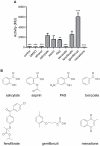The promoter of Rv0560c is induced by salicylate and structurally-related compounds in Mycobacterium tuberculosis
- PMID: 22485172
- PMCID: PMC3317779
- DOI: 10.1371/journal.pone.0034471
The promoter of Rv0560c is induced by salicylate and structurally-related compounds in Mycobacterium tuberculosis
Abstract
Mycobacterium tuberculosis, the causative agent of tuberculosis (TB), is a major global health threat. During infection, bacteria are believed to encounter adverse conditions such as iron depletion. Mycobacteria synthesize iron-sequestering mycobactins, which are essential for survival in the host, via the intermediate salicylate. Salicylate is a ubiquitous compound which is known to induce a mild antibiotic resistance phenotype. In M. tuberculosis salicylate highly induces the expression of Rv0560c, a putative methyltransferase. We identified and characterized the promoter and regulatory elements of Rv0560c. P(Rv0560c) activity was highly inducible by salicylate in a dose-dependent manner. The induction kinetics of P(Rv0560c) were slow, taking several days to reach maximal activity, which was sustained over several weeks. Promoter activity could also be induced by compounds structurally related to salicylate, such as aspirin or para-aminosalicylic acid, but not by benzoate, indicating that induction is specific to a structural motif. The -10 and -35 promoter elements were identified and residues involved in regulation of promoter activity were identified in close proximity to an inverted repeat spanning the -35 promoter element. We conclude that Rv0560c expression is controlled by a yet unknown repressor via a highly-inducible promoter.
Conflict of interest statement
Figures





Similar articles
-
Mycobacterium tuberculosis Rv0560c is not essential for growth in vitro or in macrophages.Tuberculosis (Edinb). 2017 Jan;102:3-7. doi: 10.1016/j.tube.2016.11.001. Epub 2016 Nov 5. Tuberculosis (Edinb). 2017. PMID: 28061949 Free PMC article.
-
A comparison of Rv0559c and Rv0560c expression in drug-resistant Mycobacterium tuberculosis in response to first-line antituberculosis drugs.Tuberculosis (Edinb). 2018 Jan;108:64-69. doi: 10.1016/j.tube.2017.11.002. Epub 2017 Nov 4. Tuberculosis (Edinb). 2018. PMID: 29523329
-
Salicylate uniquely induces a 27-kDa protein in tubercle bacillus.FEMS Microbiol Lett. 2001 Sep 25;203(2):211-6. doi: 10.1111/j.1574-6968.2001.tb10843.x. FEMS Microbiol Lett. 2001. PMID: 11583850
-
Co-induction of methyltransferase Rv0560c by naphthoquinones and fibric acids suggests attenuation of isoprenoid quinone action in Mycobacterium tuberculosis.Can J Microbiol. 2004 Oct;50(10):771-8. doi: 10.1139/w04-067. Can J Microbiol. 2004. PMID: 15644891
-
The effects of salicylate on bacteria.Int J Biochem Cell Biol. 2000 Oct;32(10):1029-43. doi: 10.1016/s1357-2725(00)00042-x. Int J Biochem Cell Biol. 2000. PMID: 11091136 Review.
Cited by
-
Mycobacterium tuberculosis folate metabolism and the mechanistic basis for para-aminosalicylic acid susceptibility and resistance.Antimicrob Agents Chemother. 2015 Sep;59(9):5097-106. doi: 10.1128/AAC.00647-15. Epub 2015 Jun 1. Antimicrob Agents Chemother. 2015. PMID: 26033719 Free PMC article. Review.
-
Increased Susceptibility of Mycobacterium tuberculosis to Ethionamide by Expressing PPs-Induced Rv0560c.Antibiotics (Basel). 2022 Oct 4;11(10):1349. doi: 10.3390/antibiotics11101349. Antibiotics (Basel). 2022. PMID: 36290007 Free PMC article.
-
Methionine Antagonizes para-Aminosalicylic Acid Activity via Affecting Folate Precursor Biosynthesis in Mycobacterium tuberculosis.Front Cell Infect Microbiol. 2018 Nov 12;8:399. doi: 10.3389/fcimb.2018.00399. eCollection 2018. Front Cell Infect Microbiol. 2018. PMID: 30483484 Free PMC article.
-
Morphological profiling of tubercle bacilli identifies drug pathways of action.Proc Natl Acad Sci U S A. 2020 Aug 4;117(31):18744-18753. doi: 10.1073/pnas.2002738117. Epub 2020 Jul 17. Proc Natl Acad Sci U S A. 2020. PMID: 32680963 Free PMC article.
-
Mycobacterium tuberculosis Rv0560c is not essential for growth in vitro or in macrophages.Tuberculosis (Edinb). 2017 Jan;102:3-7. doi: 10.1016/j.tube.2016.11.001. Epub 2016 Nov 5. Tuberculosis (Edinb). 2017. PMID: 28061949 Free PMC article.
References
-
- WHO. Global tuberculosis control: Epidemiology, strategy, financing. 2009. World Health Organization report.
-
- Ulrichs T, Kaufmann SH. New insights into the function of granulomas in human tuberculosis. J Pathol. 2006;208:261–269. - PubMed
-
- Young M, Mukamolova GV, Kaprelyants AS. Parish T, editor. Mycobacterial dormancy and its relation to persistence. Mycobacterium: Molecular Microbiology: Horizon bioscience. 2005. pp. 265–320.
-
- Stewart GR, Papatheodorou I, Young D. Parish T, editor. The stress response. Mycobacterium: Molecular Microbiology: Horizon Bioscience. 2005. pp. 245–265.
Publication types
MeSH terms
Substances
LinkOut - more resources
Full Text Sources
Molecular Biology Databases

